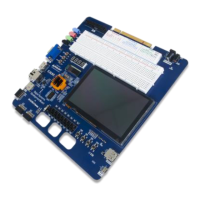NI Digital System Development Board User Manual | © National Instruments | 29
After start-up, writing to the display is done by sending data bytes over the serial interface (D/C#
high). Each data bit corresponds to a pixel with the addressing mode, inversion, and scan
direction settings determining exactly which.
VGA Port
The DSDB board uses 18 programmable logic pins to create an analog VGA output port. This
translates to 16-bit color depth and two standard sync signals (HS – Horizontal Sync, and VS –
Vertical Sync). The digital-to-analog conversion is done using a simple R-2R resistor ladder.
The ladder works in conjunction with the 75- termination resistance of the VGA display to
create 32 and 64 analog signal levels; red, blue, and green VGA signals. This circuit, shown in
Figure 9, produces video color signals that proceed in equal increments between 0 V (fully off)
and 0.7 V (fully on). With 5 bits each for red and blue and 6 bits for green, 65,536 (32 × 32 × 64)
different colors can be displayed, one for each unique 16-bit pattern.
A video controller circuit must be created in programmable logic to drive the sync and color
signals with the correct timing in order to produce a working display system.
VGA System Timing
VGA signal timings are specified, published, copyrighted, and sold by the VESA organization.
The following VGA system timing information is provided as an example of how a VGA
monitor might be driven in 640 by 480 mode.
Note For more precise information, or for information on other VGA frequencies,
refer to documentation available at the VESA website.
CRT-based VGA displays use amplitude-modulated moving electron beams (or cathode rays) to
display information on a phosphor-coated screen. LCD displays use an array of switches that can
impose a voltage across a small amount of liquid crystal, thereby changing light permittivity
through the crystal on a pixel-by-pixel basis. Although the following description is limited to
CRT displays, LCD displays have evolved to use the same signal timings as CRT displays (so
the signals discussion below pertains to both CRTs and LCDs). Color CRT displays use three
electron beams (one for red, one for blue, and one for green) to energize the phosphor that coats
the inner side of the display end of a cathode ray tube (see Figure 10).
COM pins configuration 0xDA, 0x00
Addressing mode: horizontal 0x20
Table 13. OLED Configuration Commands (Continued)
Command Function Command Bytes

